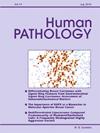黏液悬浮肿瘤芽状结构在结直肠癌中的意义
IF 2.7
2区 医学
Q2 PATHOLOGY
引用次数: 0
摘要
肿瘤萌芽(TB)是结直肠癌(CRC)不良预后的独立预测因子,定义为肿瘤浸润边缘少于5个肿瘤细胞的群集。根据国际共识标准(ITBCC),结核病应从非粘液区进行评估。然而,一些肿瘤在细胞外粘蛋白池中也含有肿瘤芽状结构,这些结构对预后的影响尚不清楚。为了评估这一点,我们定义了一个改进的肿瘤芽出变量(TB-Muc),代表在侵袭边缘热点(0.785 mm2)观察到的最高数量的肿瘤芽/芽样结构,包括细胞外粘蛋白区域。我们分析了TB (ITBCC标准)和TB- muc在两个CRC队列(N = 1876)中的预后意义。TB-ITBCC与晚期和淋巴血管侵犯相关(p <;0.001),但与其他预后因素无关的癌症特异性生存期也较短(队列1:HR高vs低1.99,95% CI 1.32-3.01, ptrend = 0.0007;队列2:HR 1.35, 95% CI 0.98-1.85, ptrend = 0.037)。TB-Muc与较短的癌症特异性生存期具有可比的独立关联(队列1:HR高vs低为1.77,95% CI 1.18-2.65, ptrend = 0.006;队列2:HR 1.39, 95% CI 1.02-1.89, ptrend = 0.019)。我们的研究结果表明,黏液蛋白中的肿瘤芽样结构不提供额外的预后价值,不应纳入结核病评估。本文章由计算机程序翻译,如有差异,请以英文原文为准。
Significance of mucin-suspended tumor bud-like structures in colorectal cancer
Tumor budding (TB) is an independent predictor of adverse prognosis in colorectal cancer (CRC), defined as clusters of fewer than 5 tumor cells at the invasive margin of cancer. According to the international consensus criteria (ITBCC), TB should be evaluated from the non-mucinous regions. However, some tumors also contain tumor bud-like structures within extracellular mucin pools, and the prognostic impact of these structures remains unclear. To assess this, we defined a modified tumor budding variable (TB-Muc), representing the highest number of tumor buds/bud-like structures observed in a hotspot (0.785 mm2) at the invasive margin, including extracellular mucin regions. We analyzed the prognostic significance of TB (ITBCC criteria) and TB-Muc in two CRC cohorts (N = 1876). TB-ITBCC was associated with advanced stage and lymphovascular invasion (p < 0.001) but also with shorter cancer-specific survival independent of other prognostic factors (Cohort 1: HR for high vs. low 1.99, 95 % CI 1.32–3.01, ptrend = 0.0007; Cohort 2: HR 1.35, 95 % CI 0.98–1.85, ptrend = 0.037). TB-Muc had a comparable independent association with shorter cancer-specific survival (Cohort 1: HR for high vs. low 1.77, 95 % CI 1.18–2.65, ptrend = 0.006; Cohort 2: HR 1.39, 95 % CI 1.02–1.89, ptrend = 0.019). Our results indicate that tumor bud-like structures in mucin do not provide additional prognostic value and should not be included in TB evaluation.
求助全文
通过发布文献求助,成功后即可免费获取论文全文。
去求助
来源期刊

Human pathology
医学-病理学
CiteScore
5.30
自引率
6.10%
发文量
206
审稿时长
21 days
期刊介绍:
Human Pathology is designed to bring information of clinicopathologic significance to human disease to the laboratory and clinical physician. It presents information drawn from morphologic and clinical laboratory studies with direct relevance to the understanding of human diseases. Papers published concern morphologic and clinicopathologic observations, reviews of diseases, analyses of problems in pathology, significant collections of case material and advances in concepts or techniques of value in the analysis and diagnosis of disease. Theoretical and experimental pathology and molecular biology pertinent to human disease are included. This critical journal is well illustrated with exceptional reproductions of photomicrographs and microscopic anatomy.
 求助内容:
求助内容: 应助结果提醒方式:
应助结果提醒方式:


